NISSAN VERSA 2019 User Guide
Manufacturer: NISSAN, Model Year: 2019, Model line: VERSA, Model: NISSAN VERSA 2019Pages: 372, PDF Size: 4.17 MB
Page 11 of 372
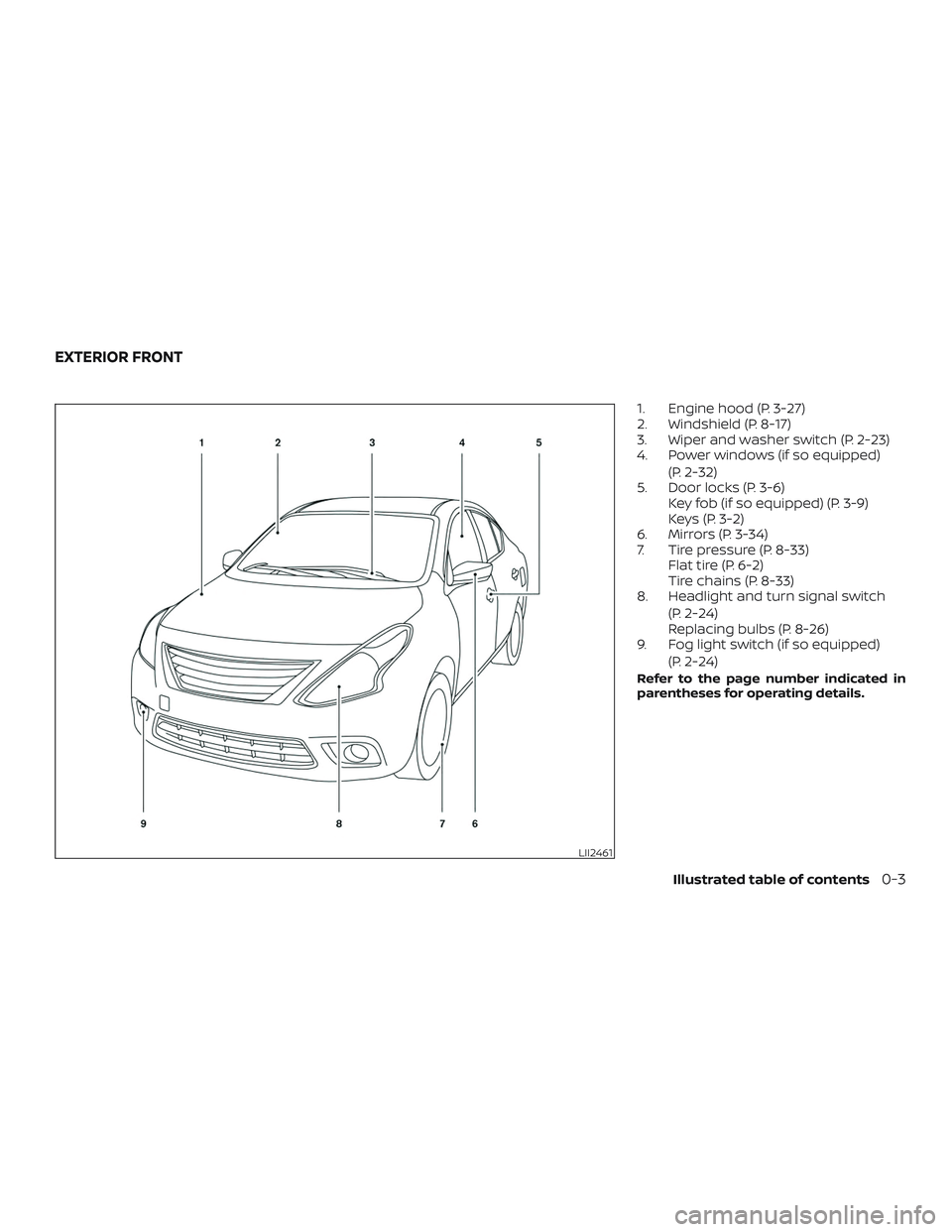
1. Engine hood (P. 3-27)
2. Windshield (P. 8-17)
3. Wiper and washer switch (P. 2-23)
4. Power windows (if so equipped)(P. 2-32)
5. Door locks (P. 3-6) Key fob (if so equipped) (P. 3-9)
Keys (P. 3-2)
6. Mirrors (P. 3-34)
7. Tire pressure (P. 8-33) Flat tire (P. 6-2)
Tire chains (P. 8-33)
8. Headlight and turn signal switch
(P. 2-24)
Replacing bulbs (P. 8-26)
9. Fog light switch (if so equipped)
(P. 2-24)
Refer to the page number indicated in
parentheses for operating details.
LII2461
EXTERIOR FRONT
Illustrated table of contents0-3
Page 12 of 372
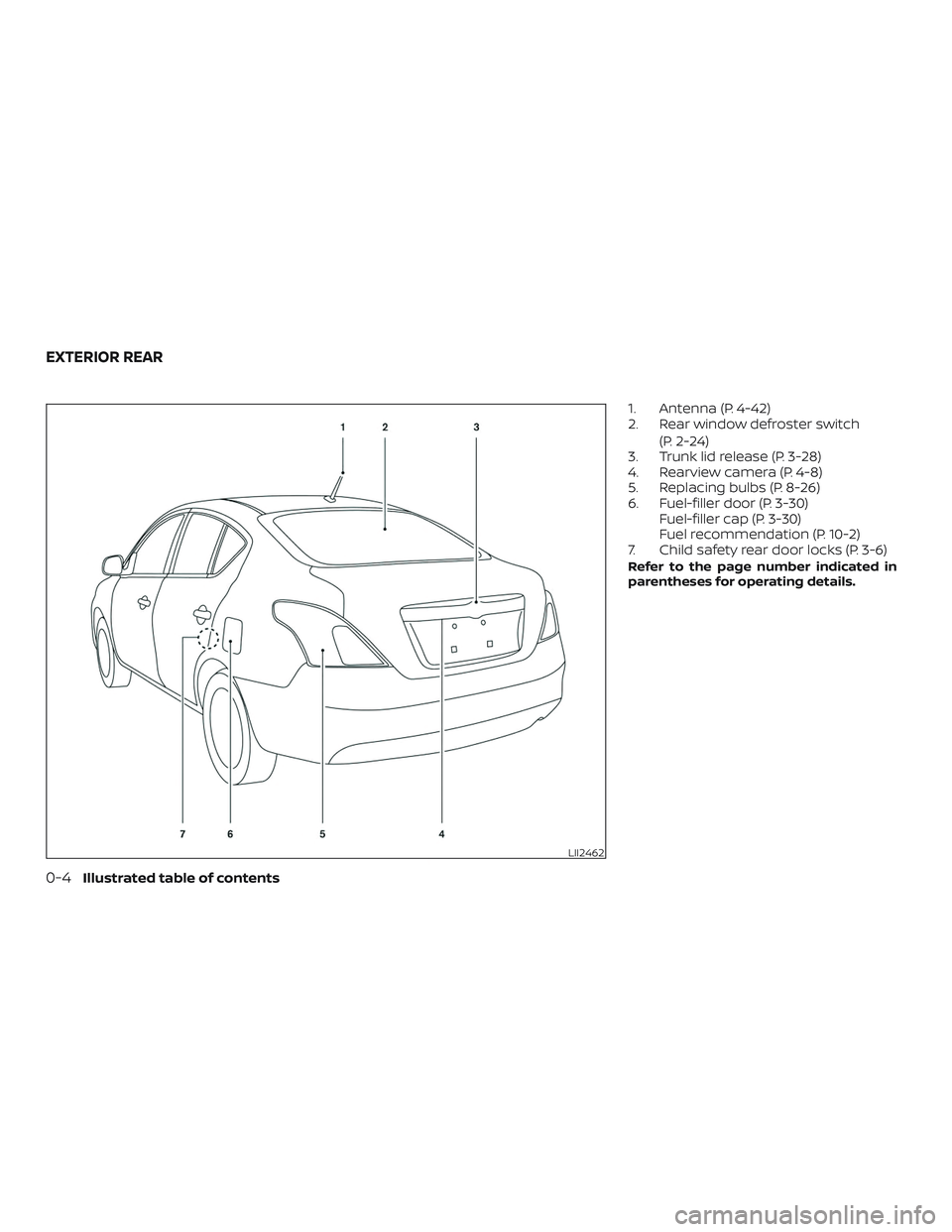
1. Antenna (P. 4-42)
2. Rear window defroster switch(P. 2-24)
3. Trunk lid release (P. 3-28)
4. Rearview camera (P. 4-8)
5. Replacing bulbs (P. 8-26)
6. Fuel-filler door (P. 3-30) Fuel-filler cap (P. 3-30)
Fuel recommendation (P. 10-2)
7. Child safety rear door locks (P. 3-6)
Refer to the page number indicated in
parentheses for operating details.
LII2462
EXTERIOR REAR
0-4Illustrated table of contents
Page 13 of 372

1. Interior light (P. 2-34)
2. Sun visors (P. 3-33)
3. Map light (P. 2-34)
4. Rearview mirror (P. 3-34)
5. Glove box (P. 2-29)
6. Parking brake (P. 5-23)
Refer to the page number indicated in
parentheses for operating details.
LII2463
PASSENGER COMPARTMENT
Illustrated table of contents0-5
Page 14 of 372
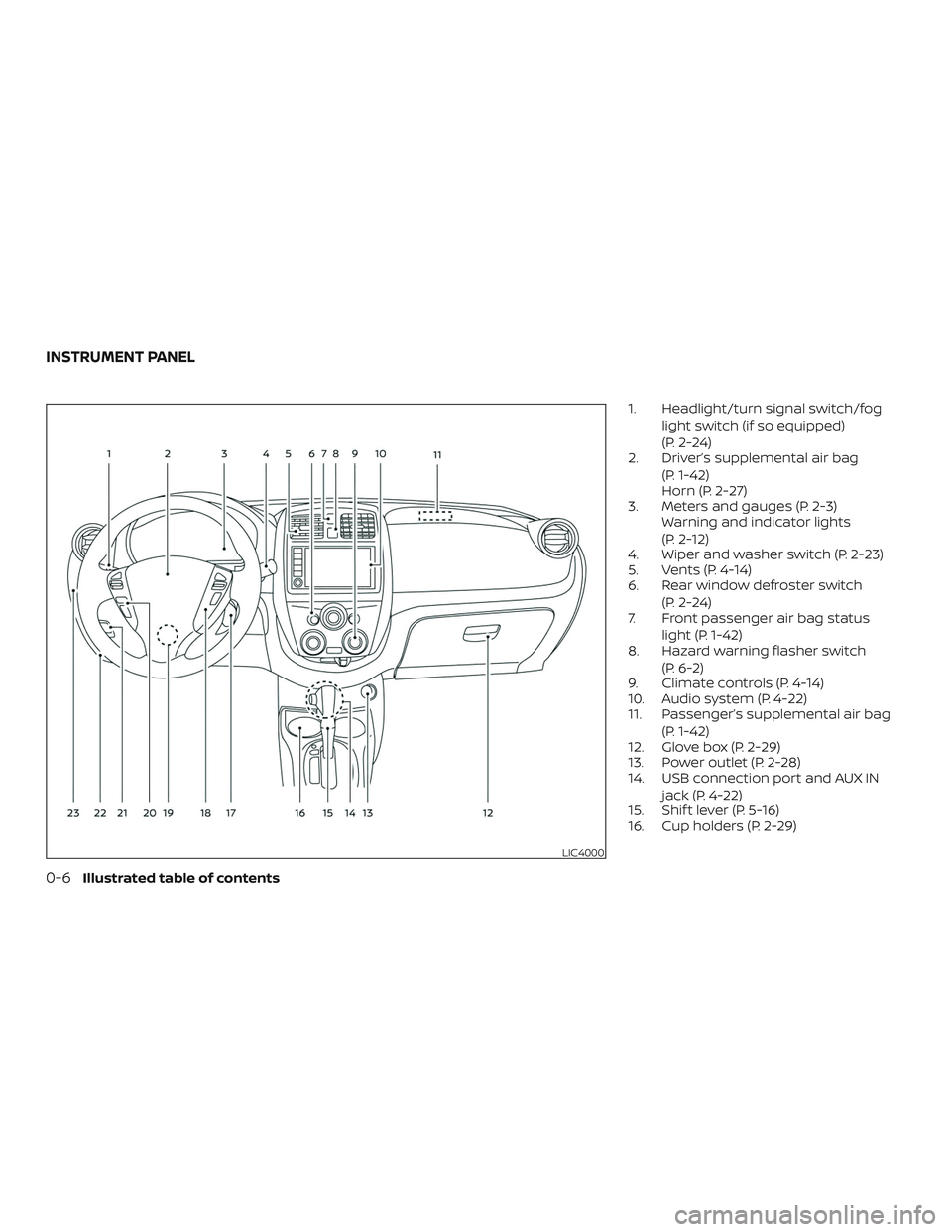
1. Headlight/turn signal switch/foglight switch (if so equipped)
(P. 2-24)
2. Driver’s supplemental air bag
(P. 1-42)
Horn (P. 2-27)
3. Meters and gauges (P. 2-3) Warning and indicator lights
(P. 2-12)
4. Wiper and washer switch (P. 2-23)
5. Vents (P. 4-14)
6. Rear window defroster switch
(P. 2-24)
7. Front passenger air bag status
light (P. 1-42)
8. Hazard warning flasher switch
(P. 6-2)
9. Climate controls (P. 4-14)
10. Audio system (P. 4-22)
11. Passenger’s supplemental air bag
(P. 1-42)
12. Glove box (P. 2-29)
13. Power outlet (P. 2-28)
14. USB connection port and AUX IN
jack (P. 4-22)
15. Shif t lever (P. 5-16)
16. Cup holders (P. 2-29)
LIC4000
INSTRUMENT PANEL
0-6Illustrated table of contents
Page 15 of 372
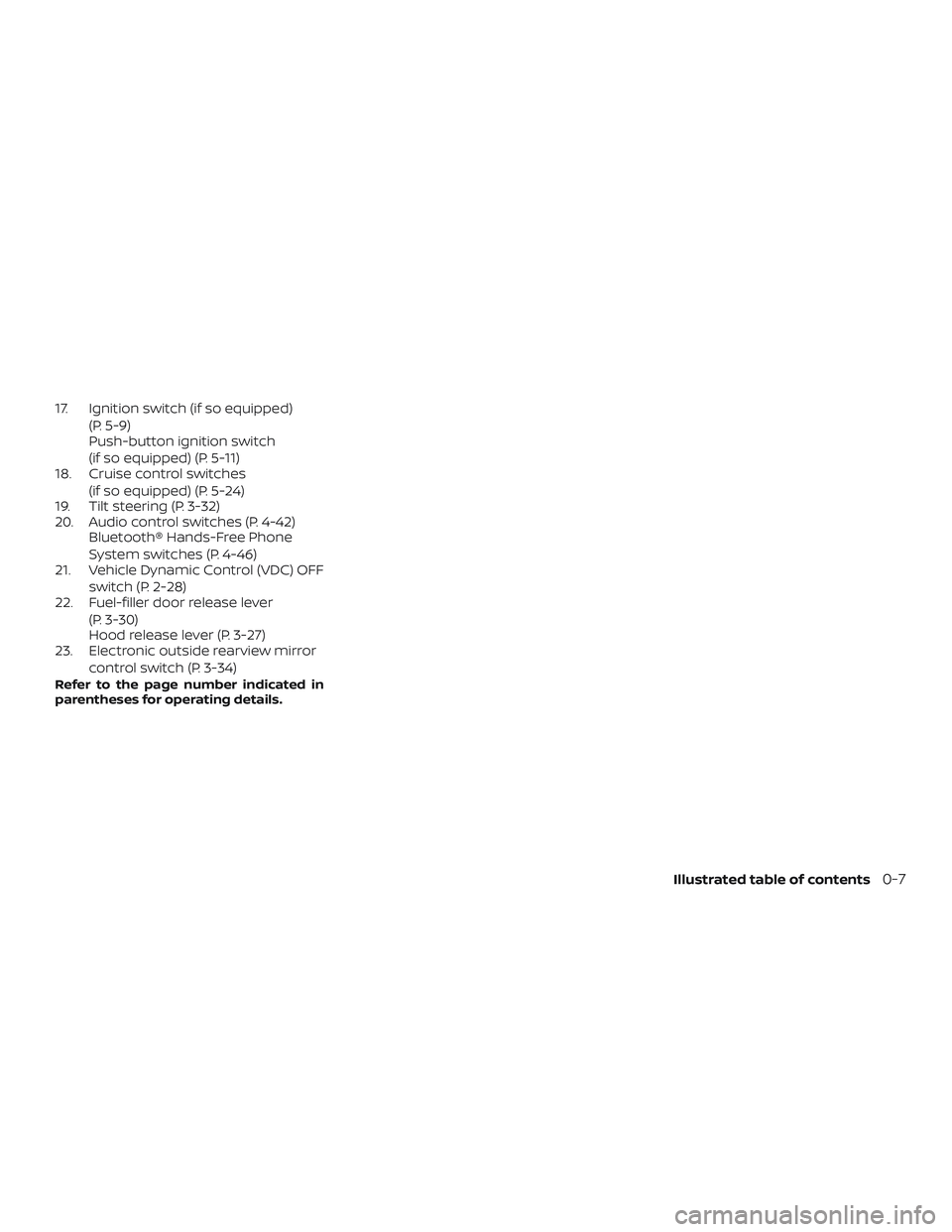
17. Ignition switch (if so equipped)(P. 5-9)
Push-button ignition switch
(if so equipped) (P. 5-11)
18. Cruise control switches
(if so equipped) (P. 5-24)
19. Tilt steering (P. 3-32)
20. Audio control switches (P. 4-42) Bluetooth® Hands-Free Phone
System switches (P. 4-46)
21. Vehicle Dynamic Control (VDC) OFF
switch (P. 2-28)
22. Fuel-filler door release lever
(P. 3-30)
Hood release lever (P. 3-27)
23. Electronic outside rearview mirror
control switch (P. 3-34)
Refer to the page number indicated in
parentheses for operating details.
Illustrated table of contents0-7
Page 16 of 372

HR16DE Engine
1. Drive belt location (P. 8-15)
2. Engine oil filler cap (P. 8-7)
3. Air cleaner (P. 8-17)
4. Brake and clutch (if so equipped)fluid reservoir (P. 8-10)
5. Fusible link (P. 8-19)
6. Battery (P. 8-13)
7. Engine coolant reservoir (P. 8-5)
8. Radiator cap (P. 8-5)
9. Engine oil dipstick (P. 8-7)
10. Windshield-washer fluid reservoir
(P. 8-11)
Refer to the page number indicated in
parentheses for operating details.
LDI3231
ENGINE COMPARTMENT CHECK
LOCATIONS
0-8Illustrated table of contents
Page 17 of 372
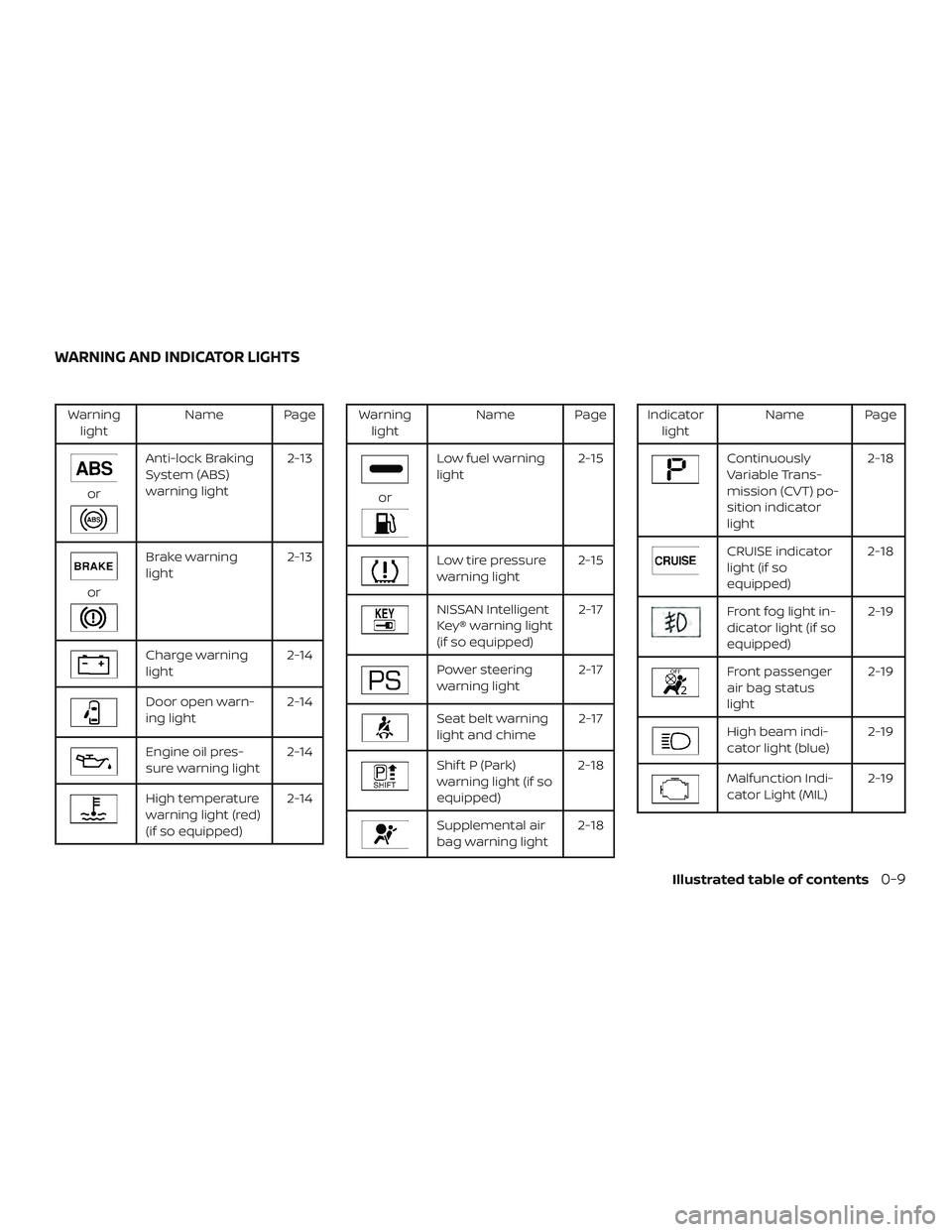
Warninglight Name Page
or
Anti-lock Braking
System (ABS)
warning light 2-13
or
Brake warning
light
2-13
Charge warning
light2-14
Door open warn-
ing light2-14
Engine oil pres-
sure warning light2-14
High temperature
warning light (red)
(if so equipped)2-14
Warning
light Name Page
or
Low fuel warning
light 2-15
Low tire pressure
warning light2-15
NISSAN Intelligent
Key® warning light
(if so equipped) 2-17
Power steering
warning light
2-17
Seat belt warning
light and chime2-17
Shif t P (Park)
warning light (if so
equipped)2-18
Supplemental air
bag warning light
2-18
Indicator
light Name Page
Continuously
Variable Trans-
mission (CVT) po-
sition indicator
light 2-18
CRUISE indicator
light (if so
equipped)
2-18
Front fog light in-
dicator light (if so
equipped) 2-19
Front passenger
air bag status
light2-19
High beam indi-
cator light (blue)
2-19
Malfunction Indi-
cator Light (MIL)2-19
WARNING AND INDICATOR LIGHTS
Illustrated table of contents0-9
Page 18 of 372

Indicatorlight Name Page
Overdrive OFF
indicator light (if
so equipped) 2-20
Security indicator
light (if so
equipped) 2-22
Side light and
headlight indica-
tor light (green) (if
so equipped)2-20
Slip indicator light 2-20
Turn signal/
hazard indicator
lights
2-20
Vehicle Dynamic
Control (VDC) OFF
indicator light2-20
0-10Illustrated table of contents
Page 19 of 372
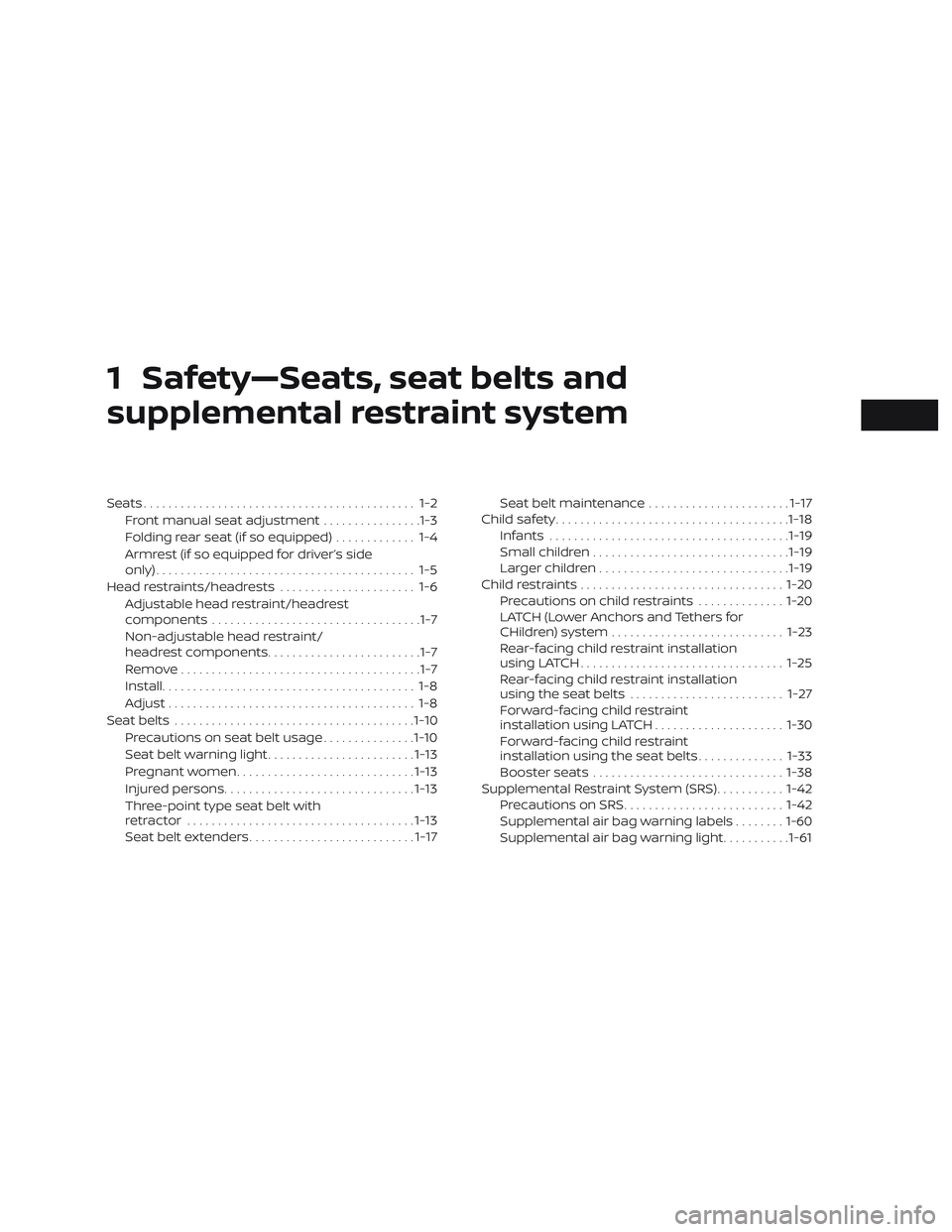
1 Safety—Seats, seat belts and
supplemental restraint system
Seats............................................ 1-2Front manual seat adjustment ................1-3
Folding rear seat (if so equipped) ............. 1-4
Armrest (if so equipped for driver’s side
only).......................................... 1-5
Head restraints/headrests ...................... 1-6
Adjustable head restraint/headrest
components ..................................1-7
Non-adjustable head restraint/
headrest components .........................1-7
Remove.......................................1-7
Install ......................................... 1-8
Adjust ........................................ 1-8
Seatbelts ....................................... 1-10
Precautions on seat belt usage ...............1-10
Seat belt warning light ........................ 1-13
Pregnant women ............................. 1-13
Injured persons ............................... 1-13
Three-point type seat belt with
retractor ..................................... 1-13
Seat belt extenders ........................... 1-17Seat belt maintenance
.......................1-17
Child safety ...................................... 1-18
Infants ....................................... 1-19
Small children ................................ 1-19
Larger children ............................... 1-19
Child restraints ................................. 1-20
Precautions on child restraints ..............1-20
LATCH (Lower Anchors and Tethers for
CHildren) system ............................ 1-23
Rear-facing child restraint installation
using LATCH ................................. 1-25
Rear-facing child restraint installation
using the seat belts ......................... 1-27
Forward-facing child restraint
installation using LATCH .....................1-30
Forward-facing child restraint
installation using the seat belts ..............1-33
Booster seats ............................... 1-38
Supplemental Restraint System (SRS) ...........1-42
Precautions on SRS .......................... 1-42
Supplemental air bag warning labels ........1-60
Supplemental air bag warning light ...........1-61
Page 20 of 372
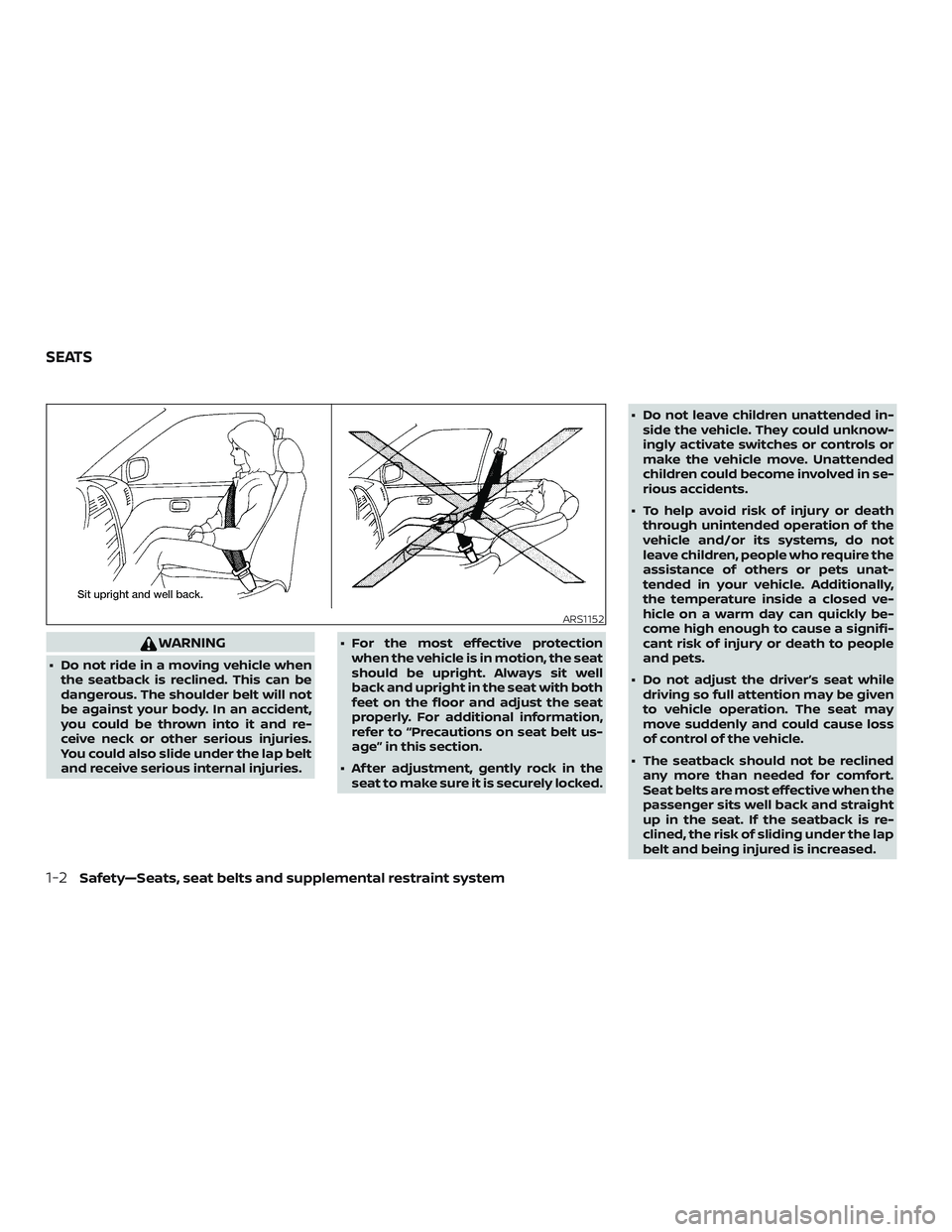
WARNING
∙ Do not ride in a moving vehicle whenthe seatback is reclined. This can be
dangerous. The shoulder belt will not
be against your body. In an accident,
you could be thrown into it and re-
ceive neck or other serious injuries.
You could also slide under the lap belt
and receive serious internal injuries. ∙ For the most effective protection
when the vehicle is in motion, the seat
should be upright. Always sit well
back and upright in the seat with both
feet on the floor and adjust the seat
properly. For additional information,
refer to “Precautions on seat belt us-
age” in this section.
∙ Af ter adjustment, gently rock in the seat to make sure it is securely locked. ∙ Do not leave children unattended in-
side the vehicle. They could unknow-
ingly activate switches or controls or
make the vehicle move. Unattended
children could become involved in se-
rious accidents.
∙ To help avoid risk of injury or death through unintended operation of the
vehicle and/or its systems, do not
leave children, people who require the
assistance of others or pets unat-
tended in your vehicle. Additionally,
the temperature inside a closed ve-
hicle on a warm day can quickly be-
come high enough to cause a signifi-
cant risk of injury or death to people
and pets.
∙ Do not adjust the driver’s seat while driving so full attention may be given
to vehicle operation. The seat may
move suddenly and could cause loss
of control of the vehicle.
∙ The seatback should not be reclined any more than needed for comfort.
Seat belts are most effective when the
passenger sits well back and straight
up in the seat. If the seatback is re-
clined, the risk of sliding under the lap
belt and being injured is increased.
ARS1152
SEATS
1-2Safety—Seats, seat belts and supplemental restraint system